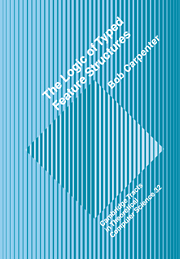 The Logic of Typed Feature Structures
The Logic of Typed Feature Structures 2 - Types and Inheritance
Published online by Cambridge University Press: 12 October 2009
Summary
From the outside, our feature structures look much like the ψ-terms of Aït-Kaci (1984, 1986) or the feature structures of Pollard and Sag (1987), Moshier (1988) or Pollard and Moshier (1990). In particular, a feature structure is modeled by a possibly cyclic directed graph with labels on all of the nodes and arcs. Each node is labeled with a symbol representing its type, and the arcs are labeled with symbols representing features. We think of our types as organizing feature structures into natural classes. In this role, our types are doing the same duty as concepts in a terminological knowledge representation system (Brachman and Schmolze 1985, Brachman, Fikes, and Levesque 1983, Mac Gregor 1988) or abstract data types in object-oriented programming languages (Cardelli and Wegner 1985). Thus it is natural to think of the types as being organized in an inheritance hierarchy based on their generality. Feature structure unification is then modified so that two feature structures can only be unified if their types are compatible according to the primitive hierarchy of types.
In this chapter, we discuss how type inheritance hierarchies can be specified and the restrictions that we impose on them that allow us to define an adequate notion of type inference, which is necessary during unification. These restrictions were first noted by Aït-Kaci (1984) in his unification-based reasoning system. The polymorphism allowed in our type system is based on inheritance in which a subtype inherits information from all of its supertypes. The possibility of more than one supertype for a given type allows for multiple inheritance.
- Type
- Chapter
- Information
- The Logic of Typed Feature StructuresWith Applications to Unification Grammars, Logic Programs and Constraint Resolution, pp. 11 - 32Publisher: Cambridge University PressPrint publication year: 1992
